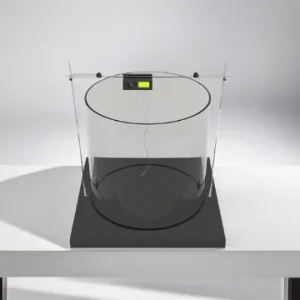$3,490.00 – $3,995.00
The MazeEngineers automated hole board system is designed for straightforward detection of nose poke behavior within an open field setup. Our system offers extensive flexibility, including interchangeable acrylic walls, colored panels, and adaptable nose poke and floor interfaces. With your purchase, you’ll receive Conductor Software, which simplifies the operation of the hole board apparatus and facilitates automatic data logging throughout your experiments. Enjoy optimal results with enhanced ease of use.

MazeEngineers offers custom-built behavioral mazes at no extra cost—designed to fit your exact research needs. Eliminate reproducibility issues from poor sizing or lingering scent cues with precision-engineered, modular, and smart mazes that adapt in real time to animal behavior. Publish new protocols, run adaptive experiments, and push the boundaries of behavioral science.



Mouse |
Length: 40cm |
Width: 40cm |
Height: 35cm |
Diameter Holes: 3cm |
16; 9; 4 floor Hole Board included in order |
16 Nose poke detection cups included in your order |
Clear wall set is included in your order. Black and white wall sets are optional |
Rat |
Length: 60cm |
Width: 60cm |
Height: 45cm |
Diameter Holes: 5cm |
16; 9; 4 floor Hole Board included in order |
16 Nose poke detection cups included in your order |
Clear wall set is included in your order. Black and white wall sets are optional |

Take advantage of Neuralynx, Ethovision Integration, SMS and Email integration with the Conductor Science Software. No I/O Boxes Required

This apparatus is applicable in several research areas, including exploratory and anxiety-related behaviors in pharmacological studies (Gupta et al., 2015; Pandey et al., 2016), neurological development and conditions (Segabinazi et al., 2020; Haagensen et al., 2013; Havas et al., 2016), as well as psychology and psychiatric research (Verbitsky et al., 2020).
by baiting specific holes and altering their positions over sessions.
for precise nose-poke detection.
for easy customization of wall patterns, hole locations, and sensory cues.
for monitoring spatial navigation, with software like ConductVision
Automatic logging of behavior events (e.g., hole entries, durations, and latencies).
Neurodevelopmental Disorder Models: The hole board is widely used to assess behavioral phenotypes in rodent models of autism spectrum disorder (ASD), ADHD, and schizophrenia. Behavioral patterns such as repetitive dipping or hyperactivity can serve as translational markers.
Real-time notifications via SMS or email for experimental events or anomalies.
Longitudinal Monitoring: The automated features support long-term studies without repeated human interference, crucial for examining disease progression or aging-related cognitive decline.
Automatic logging of behavior events (e.g., hole entries, durations, and latencies).
Environmental Enrichment Studies: Researchers can compare exploration behavior in animals raised in enriched vs. standard environments, helping study plasticity and resilience.
Integrated IR sensors provide precise tracking of nose-poke behaviors, eliminating the need for manual observation.
The apparatus features a modular construction, allowing for easy assembly, disassembly, and customization to suit various experimental needs.
Compatible with major video tracking and analysis software, including ConductVision, facilitating comprehensive behavioral analysis.
The included Conductor Science Software enables seamless control of the apparatus and real-time data logging, enhancing experimental efficiency.
By tracking where and when animals interact with holes, researchers can assess exploration strategies, habituation, and anxiety. Patterns such as repeated visits to the same hole or preference for periphery vs. center are key indicators.
The task evaluates coordination between sensory input and motor response—important in models of neurodegenerative disease or brain injury.
When used with food rewards or aversive stimuli, the board can test decision-making, reward-seeking, and risk-avoidance behavior.

| Species | Mouse, Rat |
|---|
There are no questions yet. Be the first to ask a question about this product.
Monday – Friday
9 AM – 5 PM EST
DISCLAIMER: ConductScience and affiliate products are NOT designed for human consumption, testing, or clinical utilization. They are designed for pre-clinical utilization only. Customers purchasing apparatus for the purposes of scientific research or veterinary care affirm adherence to applicable regulatory bodies for the country in which their research or care is conducted.